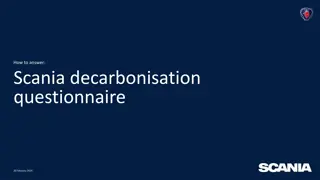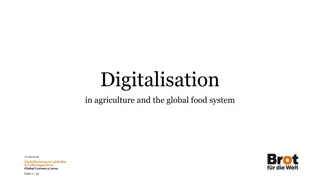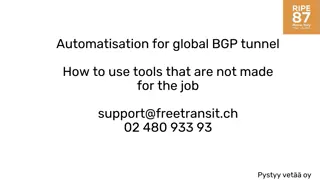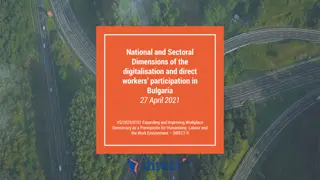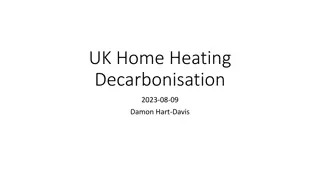Current Trends in Digitalisation, Automatisation, and Decarbonisation: Effects on European Labour Market
The evolving landscape of digitalisation, automatisation, and decarbonisation in Europe and their impacts on the labour market. Dive into the differences between structural change and transformation, the strong influence of DAD on the manufacturing industry, and the role of R&D personnel in the business enterprise sector. Uncover the implications of strategic decisions and regulations on industry sectors, particularly manufacturing, amid the shift towards a more sustainable and competitive economy.
Uploaded on Mar 13, 2025 | 2 Views
Download Presentation

Please find below an Image/Link to download the presentation.
The content on the website is provided AS IS for your information and personal use only. It may not be sold, licensed, or shared on other websites without obtaining consent from the author.If you encounter any issues during the download, it is possible that the publisher has removed the file from their server.
You are allowed to download the files provided on this website for personal or commercial use, subject to the condition that they are used lawfully. All files are the property of their respective owners.
The content on the website is provided AS IS for your information and personal use only. It may not be sold, licensed, or shared on other websites without obtaining consent from the author.
E N D
Presentation Transcript
Digitalisation, Automatisation and Decarbonisation: Current trends in Europe and expected labour market effects Barmetal: Online conference for experts, social partners and policy stakeholders 20 September 2024, 9.00 12.45 CEST Gerhard Bosch IAQ University Duisburg-Essen
Difference between structural change and transformation Structural change Shift of employees between sectors: the result of many independent market decisions Transformation Upheaval due to several simultaneous trends: digitalization, automatization and decarbonization (and in EU demographic change) Intended and thought from the end: based on policy goals, decisions and regulations: Reduction of CO2 emissions by 2050: requires complete restructuring of the economy with new regulations and huge investments in an increasingly competitive environment Long planning lead, more opportunities and more time for decisions on national, regional, company and plant level Affects several generations of employees, many of them not yet in the labor market 2
DAD has a strong impact on the manufacturing industry Manufacturing is the leading sector for the development of industry 4.0 and for decarbonization Far-reaching decisions on decarbonization in the metal industry already taken like EU ban on the sale of new petrol and diesel cars from 2035 requires reorganization of the whole value chain The 12 countries in our panel have strong manufacturing industries in nearly all countries the automotive industry most important subsector main difference: DE, FR, IT, SE have its own OEMs, Central and Eastern European countries belong to the integrated periphery in the automotive industry with high foreign ownership Central and Eastern European countries mostly production hubs with high shares of blue- collar workers Concentration of strategic services like R&D and high value-added products in countries of origin of the OEM 3
R&D personnel and researchers in business enterprise sector in manufacturing in thousands 4 Eurostat: rd_p_bempoccr2 Eurostat: rd_p_bempoccr2
Share of R&D personnel and researchers in the business entreprise sector 2022 in % Eurostat: Eurostat: rd_p_perslf rd_p_perslf 5
Impact of DAD on employment levels DAD in the past no or low impact on productivity growth - Robert Solow (1987): Productivityparadoxon Production and employment in manufacturing grew in most of the 12 countries (except FR, IT, SE and DK) Forecasts show high job risks for producers of components for combustion engines. Open question: will they be avoided by replacement production (batteries) Job losses and gains in countries may also be the result of relocations and shrinking sales not only of DAD. Successful implementation of DAD prerequisite for job retention and creation All countries try to support companies in implementing DAD: The measures range from tax reliefs to direct subsidies, promotion of R&D, expansion of IT infrastructure, targeted regional policy, modernization of VET, and promotion of social dialog - with major differences between countries 6
New skill requirements DAD project for several generations: education and initial training as important as retraining Main trends: Higher skill requirements less demand for unskilled workers New qualification profiles, in which several domains and existing occupations (metalworking, electrical engineering or information technology) are combined (like mechatronics fitter ) New skills in battery production: high-voltage electricians (licensed training) But not everybody has to be retrained: broad skills often transferable Revision of occupational profiles: More organized in the Danish and German dual system of apprenticeship by the social partners, starting in other countries in sectoral, regional or national committees in many countries lack of structured initial and further training Skill requirements will continue to change: Necessary continuous modernization of the training contents in coming decades Overall labor shortages: recruitment of foreign workers Central and Eastern European countries turn to immigration countries 7
Who is paying for retraining? Job losses can only be avoided if those affected receive further training and are placed within the company or externally Only a few countries finance further training via labor market policy - smaller qualification programs via the EU Structural Funds Individualisation of costs: disadvantage for the low skilled and SMEs Technology transfer and transfer of training programs (e.g. Volkswagen battery academy) within OEMs but not necessarily to SMEs Regional networks and regional training centers crucial for transfer to SME s: Germany: 27 regional networksfinanced through the Automotive Industry Future Fund 8
The role of social dialog and CB? The case of Germany High trade union density (40%) and coverage by collective agreements (66%, car industry 87%) in the German Metal industry Long tradition of industry wide collective agreements on job protection and retraining Recently new Future oriented CBs for DAD: Negotiated packages that include job guarantees, investment guarantees, training, and commitments to maintain locations. IG Metall represented in the National platform on Industry 4.0 : Focus on work organization, job protection and training, and Future Fund for the Automotive Industry : financing 27 regional transformation networks with a total of 200 million euros from 2022 Modernization of occupational profiles in the German dual system of vocational training decided by the social partners not the state Results:1. Social partners main actors in the transformation. 2. Personnel measures negotiated and not unilaterally determined. 3. Priority given to internal change with further training. 4. Standardized training in broad occupational profiles. 5. Effects of regional networks and Future Oriented CBs not yet evaluated But: impact of market changes: VW terminates the CA on protection against dismissals at the end of the year 9
Conclusions Just transition in the common interest of employers, employees and the state: necessary to ensure acceptance among employees, avoid labor shortages and costly unemployment Long-term technological transformation requires planning lead time: this gives time for early information of all parties involved and planning of further training and replacements - In practice, however, company case studies often show late information about investments The costs of the transformation of companies are mainly borne by the companies that also benefit from them transfer within companies across borders State support for retraining, replacement and technology transfer to SME s necessary Analysis of new skill requirements and updating of training contents together with with social partners more successful 10
Annex 12
Enterprises providing training - % of all enterprises Eurostat:trng_cvt_01s, trng_cvt_01n2 14
Share of R&D personnel and researchers in total active population Eurostat 15



